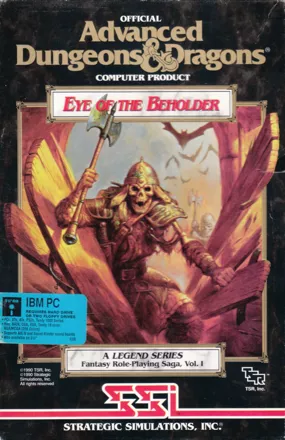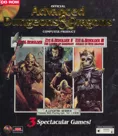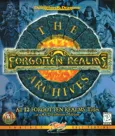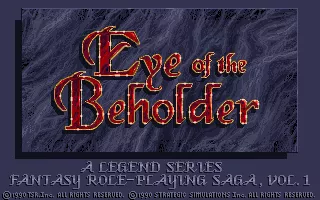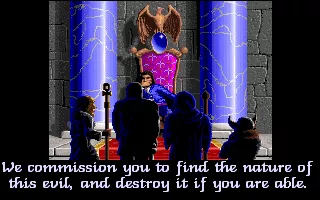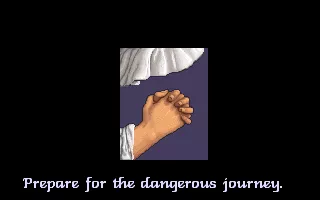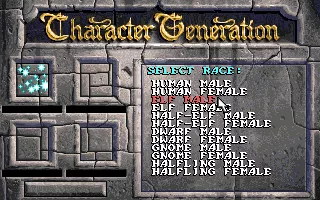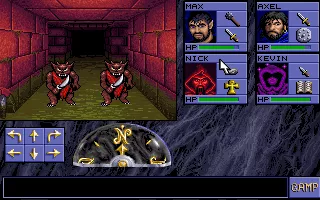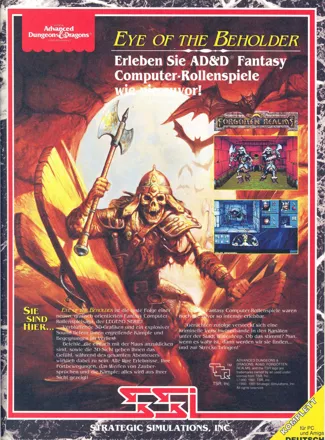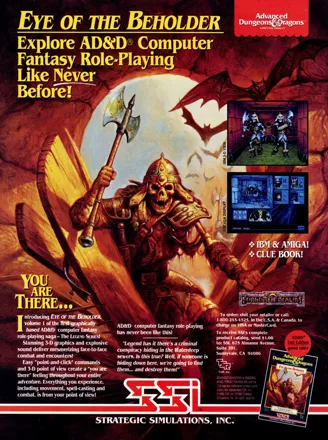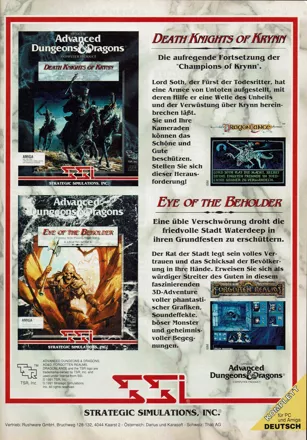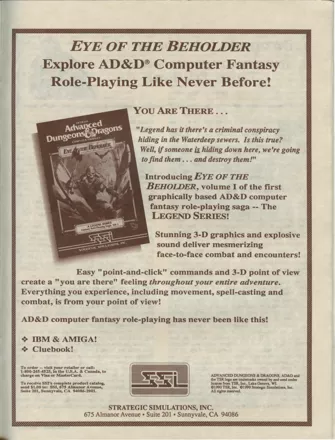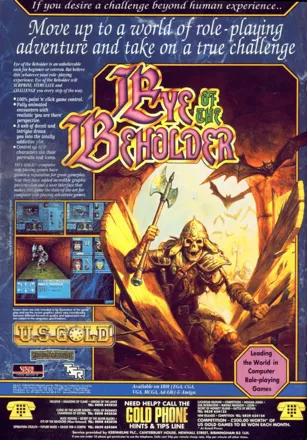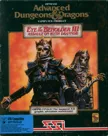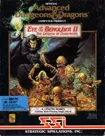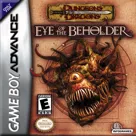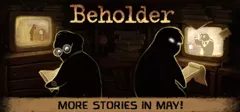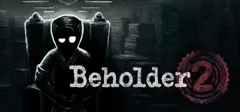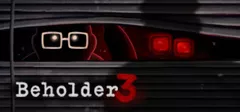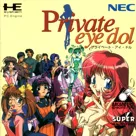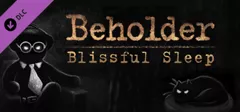Eye of the Beholder
Description official descriptions
Something evil is lurking below the city of Waterdeep. The Lords of Waterdeep summon a group of heroes to investigate, but someone or something has been watching the proceedings. After the heroes enter the sewers, the ceiling collapses behind them. The only way out is the way down, into a dungeon filled with monsters, traps and puzzles.
Eye of the Beholder is a dungeon crawler RPG with a first-person perspective based on the 2nd Edition AD&D rules. The starting party consists of four characters and up to two NPCs can join later. Combat and magic happen in real time, similarly to Dungeon Master. There is a variety of monsters to fight and spells to cast. The game features a point-and-click interface for fighting, spellcasting and handling objects.
Spellings
- アイ・オブ・ザ・ビホルダー - Japanese spelling
Groups +
- Dungeons & Dragons (D&D / AD&D) licensees
- Dungeons & Dragons Campaign Setting: Forgotten Realms
- Eye of the Beholder series
- Fantasy creatures: Dwarves
- Fantasy creatures: Elves
- Fantasy creatures: Gnomes
- Fantasy creatures: Halflings / Hobbits
- Gameplay feature: Character development - Automatic leveling
- Gameplay feature: Hunger / Thirst
- Games with manual lookup copy protection
- Genre: Dungeon crawler
- Protagonist: Female (option)
- Top Shots / Topshots releases
Screenshots
Promos
Credits (DOS version)
34 People (32 developers, 2 thanks) · View all
| Director of Product Development (Westwood) | |
| Game Design (Westwood) | |
| Original Programming (Westwood) | |
| Amiga Programming (Westwood) | |
| Graphics (Westwood) | |
| Music (Westwood) | |
| Sound Effects (Westwood) | |
| Writer (Westwood) | |
| Playtesting (Westwood) | |
| Special Thanks To |
|
| Game Development (SSI) | |
| Development Support (SSI) | |
| Manual (SSI) | |
| Playtesting (SSI) | |
| [ full credits ] | |
Reviews
Critics
Average score: 81% (based on 39 ratings)
Players
Average score: 3.7 out of 5 (based on 166 ratings with 9 reviews)
Dungeon Hacking at it's best...
The Good
EOB was by far the PC's Answer to FTL's 1988 groundbreaking game "Dungeon Master". And although similar in most gameplay aspects, EOB has enough going for it to make it an extremely enjoyable game.
The first in a trilogy of games (the second also reviewed at MobyGames), it set a PC standard that other 1st person dungeon crawls would be compared against.
Excellent game system (based on AD&D 2nd edition rules), good plot and a great dungeon crawl make EOB a classic RPG.
The Bad
The graphics were a bit drab, even for VGA graphics. Compared to Dungeon Master, it's like watching Black & White television.
The Bottom Line
If you like games like Ultima Underworld or the Original Lands Of Lore, this is a MUST HAVE in your RPG collection. Buy it, play it, and finish the game. You'll thank me for it :)
DOS · by Chris Martin (1155) · 2000
The Good
The MUSIC was terrific, it created the PERFECT ATMOSPHERE from the very moment you started to create your party. The PLAYABILITY was great, obviously you can´t compare it to a modern game but at the time it was awesome. Good and functional GRAPHICS.
The Bad
Well at times the games would get a bit difficult, specially if you didn´t have a hintbook. Luckily magazines proofed to be most helpful.
I probably have to blame this game not only for giving me a sort of "RPG-fever" that lasts until this very day. but also for making it harder for me to overcome a mild case of arachnophobia.
The Bottom Line
It was probably the second RPG I ever played on a computer (Amiga 500) and it opened my eyes to a fantastic world. The atmosphere was just binding thanks to the graphics and the music.
DOS · by lomikin (2) · 2002
A great game, but I liked its sequel much better.
The Good
Eye of the Beholder is a true classic. It spawned two sequels and while it may not have been the first, it was definitely the best RPG game for the PC at that time (in my opinion, anyway).
It had great graphics and decent engine, wonderful music, a (somewhat) innovative and effective control system and good storyline.
The Bad
Unforunately, the plot is not nearly as well executed as it was in Eye of the Beholder II: The Legend of Darkmoon, and not as interesting. Also, the game was loaded with bugs which, unfortunately, stopped me from completing it.
The Bottom Line
A real classic, shadowed by its amazing sequel, but good in its own right. Get it, play it, move on the second and be happy.
DOS · by Tomer Gabel (4534) · 2000
Discussion
| Subject | By | Date |
|---|---|---|
| correcting a review | Pseudo_Intellectual (67097) | Jan 17, 2017 |
Trivia
1001 Video Games
The PC version of Eye of the Beholder appears in the book 1001 Video Games You Must Play Before You Die by General Editor Tony Mott.
Boss
The final big boss, Xanathar is actually The Beholder, as he (is it he? or was it she? :-) says to you (when you get to the endgame for final confrontation) that all those traps you encountered, and minions you fought was just a play to watch, and that he was watching you all the way (that only gets him beholder title). Now, as you can notice, he looks like a big bowling eye, with many pipes that ends also with an eye (that gives him eye title). So, Eye of the Beholder would actually be himself.
As in this game he's the main bad guy, in Eye of the Beholder II, there are actually many creatures that are from his race, and are no such threat.
Cancelled Lynx port
This game was being ported to Atari's Lynx by NuFX, Inc., but development was halted. Prototypes have since been leaked to the internet.
Character portraits
A number of the portraits in Eye of the Beholder were Westwood employees. These include Paul Mudra (Music and Design), Phil Gorrow (Lead Programmer and Design), Joseph Hewitt (Lead Artist and Design), Mike Legg (Programmer and Design), Frank Saxxon (Artist), Aaron Powell (Artist) and Eydie Laramore (Lead Writer and Design).
Ending
Eye of the Beholder was praised for its stylish cinematic opening sequence, which dazzled players and set the stage of the game to follow. However, since the final game's size weighed in at 5 3.5" disks, SSI decided to cut the ending cinematic, figuring very few players would see it anyway, and it was not worth the extra cost of the sixth disk.
However, many players who did slog it out to the end of the game and were not amused when they were "rewarded" with a simple text message and unceremoniously dropped to DOS. SSI soon realized their mistake, but the damage could not be undone. Many players assumed the game simply never had an ending, never suspecting it existed but was not included.
The Amiga version was later released with the final endgame graphic.
Also, there was one bit of the ending that most players never saw. Players were able to do what the developer's called the "EoB Two-Step," side-stepping, turning and side-stepping again, they were able to fight many monsters including the boss with risk of taking much damage. It was possible, though time consuming, to use this technique to kill Xanathar. This is not the way the game's designers had in mind for his defeat though. The player were supposed to lure and push Xanathar into one of the spike traps where there was a small animated sequence (basically 4 frames) of him being impaled and dying.
Title
Eye of the Beholder is one of many games that shares its name with a song by the heavy metal band Metallica.
Awards
- Computer Gaming World
- November 1996 (15th anniversary issue) – #2 Least Rewarding Ending of All Time* Enchanted Realms
- September 1991 (Issue #8) – Distinctive Adventure Award
Information also contributed by Игги Друге, Martin Smith, and MAT
Analytics
Upgrade to MobyPro to view research rankings and price history! (when applicable)
Related Sites +
-
Eye of the Beholder - FAQs & Guides
A collection of walkthroughs for EOB1 on GameFaqs.com -
Eye of the Beholder Help Web
maps, walkthrough, cheats, char editors, etc. -
Eye of the Beholder I
Fan site by Stanislav Sokolov with maps, walkthrough, monster descriptions, etc. -
The All-Seeing Eye
An automapper for the DOS versions of the first two Eye of the Beholder
Identifiers +
Contribute
Are you familiar with this game? Help document and preserve this entry in video game history! If your contribution is approved, you will earn points and be credited as a contributor.
Contributors to this Entry
Game added by Chris Martin.
SNES added by SAGA_. SEGA CD added by Stillman. PC-98 added by Terok Nor. Amiga added by MAT.
Additional contributors: Tony Van, Terok Nor, xcom1602, Jeanne, Cabeza2000, Alaka, monkeyislandgirl, Joseph Hewitt, Patrick Bregger, Azif Kylander, Narushima, FatherJack.
Game added February 7, 2000. Last modified June 14, 2024.


